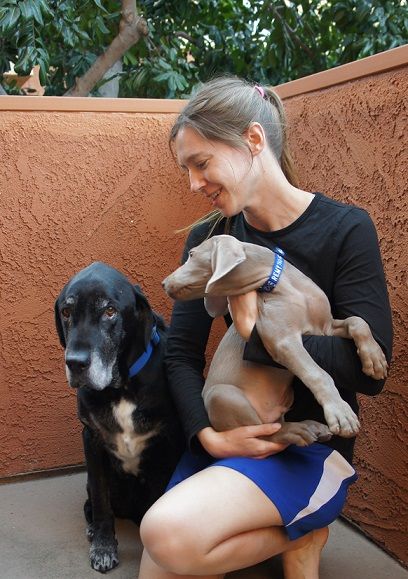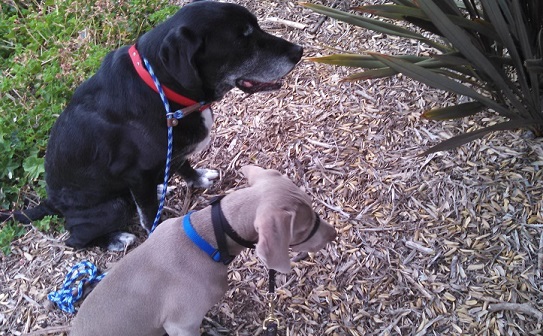Today I’m writing about how my older dog Ace needed a slow introduction (over several weeks) to our new puppy Remy.
With dogs, the question “Is he good with other dogs?” should never have a yes or no answer.
I hear this question with shelter dogs all the time, and it’s not a fair question because it sets them up for failure.
The answer should always be, “It depends.”
For example, here’s how I would answer for Ace:
“Is he good with other dogs?”
It depends. Ace is friendly with other dogs in public and has good social skills with familiar and unfamiliar dogs. However, he will snap at our puppy in our apartment if the puppy tries to jump on him, take his toy or barge up to him. He’s grumpy!

I’ve had to slowly introduce my old dog to living with a puppy.
We’ve had puppy Remy for a little over two months and today the two dogs are loose in the same room for about 20 minutes a day under supervision. The rest of the time they are separated by a gate or leashes.
Rather than throwing the puppy into my senior dog’s life, I realized the two needed a slow transition to living together.
A big help is having some highly valued treats I can stuff into Kong toys to keep both dogs occupied and calm.
How to slowly introduce two dogs that will live together
1. Introduce them outside in neutral territory
If your dog has a tendency to “guard” your yard, driveway or even your street, introduce them further away from your home such as at a nearby park.
With older puppies and adult dogs, it’s also best to keep moving and go for a short walk vs. letting them barge up head on right away. (This causes some tension and often leads to a snap or scuffle.)
2. Walk the dogs together immediately.
If possible, it’s ideal if you can walk the two dogs (with another adult to help) with one in front of the other and eventually side by side if all seems to be going well.

Walk for 40 minutes or so, if possible. This gives them some time to get used to each other, burn energy and crate a positive experience as a “pack.”
3. Create positive experiences together!
Each day I try to do something fun with my two dogs together. I give them each a Kong toy stuffed with treats while we hang out watching TV. I take them on walks together because they get along well outside.
Or, I work on simple obedience training where they are both given treats for sits, stays, downs, etc. They both like this because it’s simple, and they’re less focused on each other and more on me.
4. It’s OK to keep the dogs separated.
I originally wanted my two dogs to spend as much time together as possible in an attempt to force them to accept each other. I soon learned it’s much better to keep them separated most of the time (with gates) while we go about our normal routines.
This removes pressure from them (and me) so when they are together I have the energy to focus and make it positive.

5. Use dog gates as needed.
You may need to invest in a high-quality gate, but we have a cheap baby gate that works. I section off different areas, allowing my puppy to be out of his kennel but unable to harass my senior dog.
The gate is positive because it allows the dogs to spend time together with boundaries. Sometimes one will lounge on each side with the gate between them.
Just make sure the gate isn’t causing tension such as if one dog is always barking at the other through the gate.
6. Tether one or both dogs.
Keeping our puppy Remy on a leash and tethered to something sturdy (our heaviest dumbbells) has been helpful because it allows him to be in the living room with us in the evenings without being a complete pest to our senior dog.
We give our puppy a Kong toy stuffed with Droolers treats to keep him occupied and prevent him from getting frustrated. As with the gate, you want to make sure the leash isn’t causing too much frustration for either dog.
Other tips:
- Remove opportunities for failure. Don’t give them too much freedom together, remove any source of resource guarding like toys, bones, beds, etc.
- Reward calm behavior from all dogs; calm dogs get praise and food.
- Accept there will be setbacks, very rarely can two dogs live together and never have at least some minor scuffles. They’re dogs. This is normal.
- Always be working on training and always be setting goals (no matter how small
Let me know what else you’d add to my list.

I’d also love to hear:

Jessi
Wednesday 22nd of June 2016
I recently adopted and introduced a 4 month old puppy to my 11-12ish year old terrier. I live in a 1bd apartment and I've had Charlie for 9 years and he has always been an only dog as long as I've had him.It was rough at first but I did most of what you have written above and they are able to be out all day together without incident. It has only been about 3 weeks so I was surprised how fast Charlie adapted. They are still separated when I am not home, when eating, and when we are sleeping. It'll be interesting to see what happens when she gets bigger then him though!
Lindsay Stordahl
Thursday 23rd of June 2016
Jessi, how are you by the way? It's been a long time since I saw you!
Lindsay Stordahl
Thursday 23rd of June 2016
Oh it sounds like things are going well for only 3 weeks. Congrats on your new puppy and hang in there, Charlie! :)
Jessicavy
Wednesday 22nd of June 2016
Aw, it's so great to hear your dogs have made so much progress! I can't think of anything that you didn't already mention that worked for my dogs. Introducing Hiccup to my oldest cat was actually the hardest, years ago. We used lots of treats for both the dog and cat.
Lindsay Stordahl
Wednesday 22nd of June 2016
My cats are pretty tolerant of Remy thankfully.